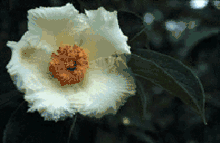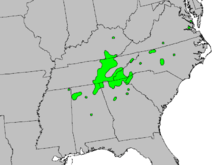Stewartia ovata
Stewartia ovata, known commonly as mountain camellia,[4] is a small tree native to low to mid-elevations in the southern Appalachian Mountains and nearby regions from Mississippi to Virginia. It is a member of the Theaceae, the tea family.
| Stewartia ovata | |
|---|---|
 | |
| Flower | |
| Scientific classification | |
| Kingdom: | Plantae |
| Clade: | Tracheophytes |
| Clade: | Angiosperms |
| Clade: | Eudicots |
| Clade: | Asterids |
| Order: | Ericales |
| Family: | Theaceae |
| Genus: | Stewartia |
| Species: | S. ovata |
| Binomial name | |
| Stewartia ovata | |
 | |
| Range | |
| Synonyms[3] | |
| |
Although not endangered, the plant does have a limited range and is uncommon throughout its range. Mountain camellia grows in the understory of predominately hardwood forests and tends to be found near streams, usually at elevations below 800 m (2,500 feet).
Description
Stewartia ovata is a deciduous flowering shrub or small tree growing to 5 meters (16 2/3 feet) tall, with smooth, flaking grayish-orange bark. The leaves are oval with an acute apex, 7–13 cm (2.8-5.2 inches) long and 3–6 cm (1.2-2.4 inches) broad, and turn orange, red, or gold when the tree becomes dormant in the fall. The flowers are camellia-like, 6–12 cm (2.4-4.8 inches) in diameter, with five white petals and numerous white, yellow or purple stamens; they appear in early to mid-summer.[5]
- Varieties
There are two varieties:
- Stewartia ovata var. ovata — flowers 6–8 cm diameter, stamens white to yellow.
- Stewartia ovata var. grandiflora (W.J.Bean) Weatherby — flowers up to 12 cm diameter, stamens purple.
References
- "Stewartia ovata". NatureServe. Retrieved 2016-10-23.
- Rivers, M.C. (2015). "Stewartia ovata". IUCN Red List of Threatened Species. 2015: e.T62086365A62086373. doi:10.2305/IUCN.UK.2015-2.RLTS.T62086365A62086373.en. Retrieved 3 May 2020.
- The Plant List, Stewartia ovata (Cav.) Weath.
- "Stewartia ovata". Natural Resources Conservation Service PLANTS Database. USDA. Retrieved 3 December 2015.
- Flora of North America, Stewartia ovata (Cavanilles) Weatherby, 1939. Mountain camellia or stewartia
External links
| Wikimedia Commons has media related to Stewartia ovata. |

